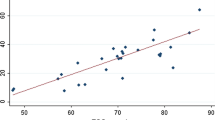Abstract
Even if the i-o method is a very popular instrument in regional studies in many countries, the generalizations concerning the crucial problems of its practical applications, i.e., compilation of a transactions table and assumption of coefficient stability, cannot be regarded as well-established. The present study deals with the methodological comparison of two i-o studies made at an interval of five years; the area under consideration is a small regional economy in Eastern Finland, Special attention is directed to the stability and influence of the most important coefficients, which are identified both on the basis of size and of a special index. Complementary findings are provided by analyzing sectoral time-series data on foreign import coefficients by regions. The conclusions derived accentuate the necessity of regional primary data in i-o accounts on the one hand, and the significance of random factors as far as the shifts of regional coefficients and their correspondence to the national ones are concerned on the other. The latter issue is obviously more important in small regional economies in highly integrated national economies, where the effect of distance on input structure by sectors is of minor importance.
Similar content being viewed by others
References
Beyers, W. B. “On the stability of Regional Interindustry Models: the Washington Data for 1963 and 1967.”Journal of Regional Science 12 (1972), 3, 363–374.
Beyers, W. B. “On the Structure and Development of Multiregional Economic Systems.”Papers of the Regional Science Association, vol. 40 (1978), 103–133.
Bourque, P. J. “An Input-Output Analysis of Economic Change in Washington State.” University of Washington Business Review, 30 (1971), 5–22.
Burford, R. L.and J. L. Katz, “Regional Input-Output Multipliers Without a Full I-O Table.”Annals of Regional Science, 11 (1977), 3, 21–38.
Central Statistical Office of Finland. Input-Output Study. The Input-Output Structure of the Finnish Economy 1970. (In Finnish with English Summary). Helsinki 1977.
Conway, R. S. “Changes in Regional Input-Output Coefficients and Regional Forecasting.”Regional Science and Urban Economies, 10 (1980), 153–171.
Conway, R. S. “The Stability of Regional Input-Output Multipliers.”Environment and Planning A, 9 (1977), 197–214.
Eskelinen, H. “Core and Periphery in a Three-Region Input-Output Framework.”Paper to the 21st RSA European Congress, Barcelona, August 1981 (mimeo).
Eskelinen, H. The North Karelian Input-Output Studies of the 1970's. Publications of Karelian Institute, University of Joensuu. (In Finnish) Joensuu 1981.
Eskelinen, H. and M. Suorsa. “A Note on Estimating Interindustry Flows.”Journal of Regional Science, 20 (1980), 261–266.
Forssell, O. “Explaining Changes in Input-Output Coefficients for Finland.” In Brody, A. and B. Carter (eds.).Input-Output Techniques, North Holland, 1972.
Jensen, R. C. “An Introspective Evaluation of the Regional Input-Output Technique.”Paper to the First World Regional Science Congress, Cambridge, Mass., June 1980 (mimeo).
Jensen, R. C. “Some Accounting Procedures and Their Effects on Input-Output Multipliers.”Annals of Regional Science, 12 (1978), 3, 21-38.
Jensen, R. C. and G. R. West. “The Effect of Relative Coefficient Size on Input-Output Multipliers.”Environment and Planning A, 12 (1980), 659–670.
Morrison, W. I. and P. Smith. “Nonsurvey Input-Output Techniques at the Small Area Level: An Evaluation.”Journal of Regional Science 14 (1974), 1, 1–14.
Mäenpää, I. “The Sensitivity of the FMS Input-Output Model to the Changes of Input Coefficients.” Mimeographed working paper, University of Oulu, Finland, 1980.
Palomäki, M. “Industrial Development and Regional Standards of Living in Finland.” In Walker, D. (ed.)Planning Industrial Development, John Wiley 1980.
Park, S. -H., M. Mohtadi and A. Kubursi. “Errors in Regional Non-Survey Input-Output Models: Analytical and Simulation Results.”Journal of Regional Science, 21 (1981), 3, 321–339.
Peschel, K. “On the Impact of Geographic Distance on the Interregional Patterns of Production and Trade.”Environment and Planning A, 13 (1981), 605–622.
Sherman, J. and W. J. Morrison. “Adjustment of an Inverse Matrix Corresponding to a Change in One Element of a Given Matrix.”Annals of Mathematical Statistics, 21 (1950).
Stevens, B. H. and G. A. Trainer. “Error Generation in Regional Input-Output Analysis and its Implications for Nonsurvey Models.” In Pleeter, S. (ed.)Economic Impact Analysis;Methodology and Applications. Studies in Applied Regional Science 19, Martinus Nijhoff 1980.
Usui, M. “Input-Output Analysis for Development Planning.”Journal of Development Planning 1972, 98–151.
Author information
Authors and Affiliations
Additional information
Some of the observations made in this article have been discussed in a preliminary way in my working paper, “Structural Change in a Small Regional Economy: Major Input Coefficients,” presented to the 4th Finnish-Soviet Symposium in Economics held in Tbilisi, USSR, November 1980.
Rights and permissions
About this article
Cite this article
Eskelinen, H. Findings on input-output in a small area context. Ann Reg Sci 17, 40–55 (1983). https://doi.org/10.1007/BF01284233
Received:
Issue Date:
DOI: https://doi.org/10.1007/BF01284233




